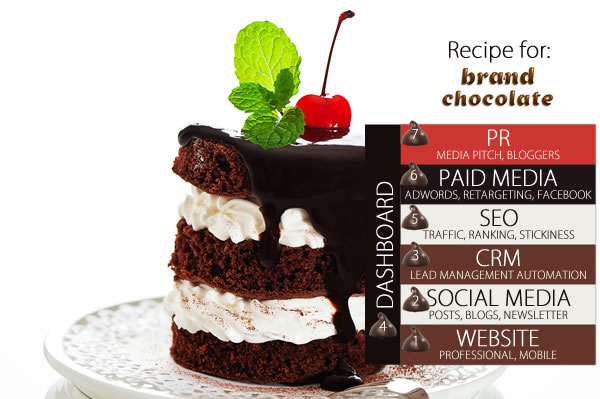
How do some brands seem to have that irresistible quality that creates a loyal following of happy clients who talk about them and refer others? How do some brands seem to be found while others disappear?
To explain, I like to use the analogy of a chocolate shop. The chocolatier’s dilemma is that she has this amazing ingredient to work with that so many people will enjoy once they experience it but there are other chocolate shops on her block, so many ways she could prepare her chocolate, and so many different customers she could serve. So how does she begin?
Begin with the customer
She begins with the customer, because she knows that people make buying decisions based on emotions, not on logic, and she needs to connect with those emotions for them to feel comfortable enough to buy.
Examples of consumer emotions are “I want to be noticed”, “I’d like to feel comfortable”, “I want to be in control” and “I want to feel special”. How she displays her chocolate, the look of her shop, and how she describes her chocolate all must connect with the emotions of her target consumers. But first she must create the right product to excite those target consumers because, as marketing guru Seth Godin says, 90% of marketing, if done right, is the product (or service).
I’m only scratching the surface here and we go much deeper into the psychology of buying and how to position your brand accordingly in the workshop “Brand Chocolate”, but this should give you a little ‘taste’, so to speak, before diving in further, because it is the critical precursor to anything else you may decide to do to market your services.
Layer 1: A Professional, Mobile-Friendly Website
So what’s the recipe for brand chocolate? What are the components to make you irresistible? If you were making a chocolate layer cake you would need to begin with the foundational layer first, and marketing is no different. At the base of your irresistible cake should be an irresistible website that has a professional appearance and looks great on a mobile device, since that is where at least 50% of your traffic comes from these days. AND a great mobile-friendly website actually impacts your Google ranking.
Layer 2: Social Media
Then we add a layer of social media, which includes blogs, newsletters and posts across a number of channels, including the most popular ones; Facebook, Google+, Twitter, Linked In, Instagram and Pinterest, ALL of which are being used successfully by businesses. Social media is critical for a couple of reasons:
- It gives your brand more exposure, which potentially leads to engagement and then ideally conversion.
- Google likes social media engagement when it points back to your website as it is viewed as a vote of relevancy.
Layer 3: CRM
CRM, which stands for Customer (or client) Relationship Management is essentially the process of taking your business down to a grass roots level, automating emails, letters, phone calls and follow ups to make it realistic for you to have that same level of relationship with each and every client and prospect. It automates what you would do naturally if only you could clone yourself.
Layer 4: Marketing Dashboard
Before you go any further with your brand chocolate layer cake, you must stop and measure your ingredients. So many businesses literally throw their money away on marketing initiatives that simply do not produce a return. As the old saying goes, “you get what you measure” and unless you are measuring the results you want, they are not going to materialize. Your dashboard will include elements of your results on social media and your web traffic compared to your competitors, which will be tracked from your SEO program. Add to this reporting from your CRM program based on your lead source funnel and now you’ll have a complete view not only of how people found you, but whether they purchased from you. Then you can look at your spend by channel and determine if it was worth it.
Layer 5: SEO
The next layer of our cake is SEO, which stands for Search Engine Optimization. Google has indexed over 4.73 billion pages of content, so for yours to be found in a search takes a little effort. By using computers to think, Google pretty much ensures that no SEO consultant will ever know exactly what it takes for a website to come out on top. That said, here is a list of things we do know Google likes:
- Fresh, new and original content.
- Local results.
- Mobile friendly pages.
- Authority sites that link to your page.
Layer 6: Paid Media
The icing on our Brand Chocolate cake is paid media, including Facebook Ads, Google Ads, Re-targeting, and Mobile Adwords. We’ll dive more into these in an upcoming post.
Layer 7: Public Relations
The cherry on top after building the Brand Chocolate layer cake is Public Relations or “PR”. This includes a strategy as simple as pitching events, to leveraging relationships with bloggers to write about you, or relationships with the media to interview you. It is critical that whoever you partner with have these established relationships and a track record of media exposure, as a good PR program will typically run thousands of dollars per month.
And most importantly, your recipe begins with a detailed understanding of for whom you are building your cake.
For more information and an opportunity to dive deeper into all of these areas to build your very own Brand Chocolate marketing plan, go to www.brandchocolate.com.

